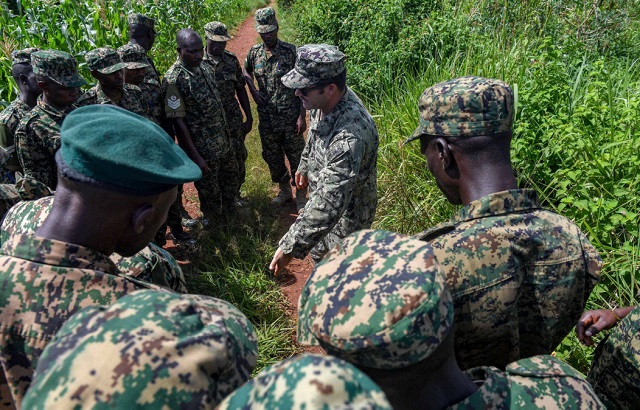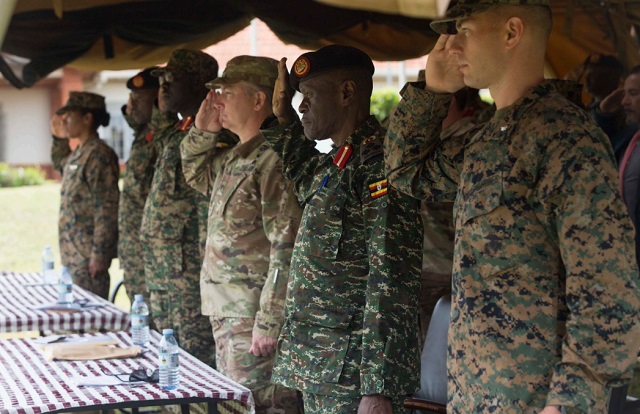
Why it remains one of the biggest beneficiaries despite poor human rights record
Kampala, Uganda | IAN KATUSIIME | A U.S. government report released in March indicated that the Uganda Peoples Defence Forces (UPDF) had the highest number of trainees among African countries who underwent foreign military training by the U.S. Department of Defence.
The data for the financial years of 2020 and 2021 was contained in a joint report presented by the U.S. Department of Defense and the Department of State to the U.S. Congress last month.
Uganda had 5049 individual students for the trainings that took place among 46 African countries. Uganda’s neighbour to the south, Rwanda, came second with 2195 trainees and followed by Ghana at 1278.
Up to 503 of the UPDF trainees were taken through peace keeping operations, others had international Military Education and Training (IMET) courses and the rest of the training was in the form of miscellaneous activities of the Department of Defence also known as the Pentagon. The trainings took place in Uganda and various parts of the U.S.
However among all the African countries, the U.S. spent more dollars on trainings conducted for Kenya Defence Forces (KDF) which only had 216 students attending the courses in the two years under review. The US spent $9 million on Kenyan trainees who had sizeable numbers on courses of foreign military financing and foreign military sales. This was in contrast to the $5.9 million spent on the courses for Uganda who had twenty times more trainees.
Timothy Pietrack, a US Africa Command spokesperson, told The Independent in an email response that Uganda’s large contribution of troops to the African Union Transition Mission in Somalia (formerly AMISOM) played a part in the high number of Ugandan trainees in the U.S. training program. The U.S. Africa Command is one of the eleven unified combatant commands of the United States Department of Defense, run out of Stuttgart, Germany. It is a partner in the training program.
“As part of that, the U.S. trains the Ugandan forces on a rotational basis and in 2020 completed the majority of training that allows for Ugandan forces to conduct organic training on a continual basis,” Pietrack said.
He said the UPDF selects personnel that meet the requirements to receive training and the U.S. government then begins the vetting process.
“In cases where an entire unit is designated to receive assistance, the Department of State vets the unit and the unit’s commander.”
He added that when an individual security force member is nominated for U.S. assistance, the Department vets that individual as well as his or her unit.
“Vetting begins in the unit’s home country, where the U.S. embassy conducts consular, political, and other security and human rights checks,” Pietrack said.
However most often, an additional review is conducted by analysts at the Department of State in Washington, D.C.
“The State Department evaluates and assesses available information about the human rights records of the unit and the individual, reviewing a full spectrum of open source and classified records,” Pietrack said.
The foreign military training report was released amid persistent calls from Ugandan members of the opposition and activists to the U.S. to cut funding for Uganda which has been on the spot for allegedly using military aid in cash and kind to crack down on government opponents.
The calls grew louder during the 2021 presidential election when scores of members of the opposition National Unity Platform (NUP) were jailed and allegedly tortured and some killed at the hands of Ugandan security operatives. Leaders of some opposition parties say the cases of torture and illegal detention have gone on in Uganda a year after the election.
A report by Human Rights Watch released in March implicated the UPDF and its sister agencies like Internal Security Organisation (ISO) in human rights abuses such as torture that goes on in safe houses.

Different types of training
Kelly Cahalan, a U.S. Africa Command spokesperson, told The Independent there are different types of training and different funding streams for a variety of trainees.
Cahalan said there are U.S. Department of State funded programs like the International Military Education and Training (IMET) for individuals to attend courses and U.S. Department of Defence programs tied to exercises or other mil-to-mil training engagements. “Uganda has participated in Exercises Cutlass Express and Justified Accord.”
Cutlass Express is a U.S. Naval Forces Africa led, all-domain exercise in East African coastal regions and the West Indian Ocean according to the US Africa Command website. The exercise is linked to U.S. Central Command’s International Maritime Exercise to counter malign influence, aggression, and activity along overlapping command seams and maritime regions.
The UPDF students units who underwent trainings in the two years range from the Air Force, Chieftaincy of Military Intelligence (CMI), UPDF military police, School of Field Artillery, Logistics and Engineering departments and many others.
There has been increased military engagement between U.S. and African countries in the recent past as the Western superpower finds itself in an age of strategic competition with two foes; China and Russia.
In the same month the Pentagon and State Department report on foreign military training was released, the U.S. hosted an African Land Forces Summit at the Maneuvre Centre of Excellence in Fort Benning, Georgia.
Lt. Gen. Muhoozi Kainerugaba, the Commander of the Land Forces in the UPDF, did not attend the summit held from March 21-25. The Independent could not confirm whether Muhoozi was invited by the US Africa Command for the summit since he is arguably the most visible Land Forces commander on the African continent.
The purpose of the summit was to help strengthen partnerships, advance security, stability, and peace in Africa. Over 40 African nations attended the event including representatives from Malawi, Ghana.
U.S. foreign military training is coordinated by the Bureau of Political-Military Affairs; a State Department office that integrates diplomacy and defence. The Bureau is the State Department’s principal link to the Department of Defense. The Bureau has been engaged with Uganda on several partnerships at a time of heightened security and terrorism challenges.
A U.S. State Department spokesperson re-affirmed the role of Uganda at the peacekeeping mission in Somalia to the U.S. when asked about Uganda’s high numbers in U.S. military training programmes. Uganda has a 6000 troop contingent at the newly named ATMIS.
For Kenya, the higher cost of training fewer Kenyan forces can be attributed to more expensive types of training, the spokesperson told The Independent in an email response.
U.S. Forces in Somalia working alongside Ugandan troops were involved in training of the Somali National Army (SNA). The estimated 700 U.S. personnel however left in January 2021 and the UPDF has taken on the mantle of training the SNA.
The Bureau of Political-Military Affairs has partnered with the Regional Centre on Small Arms (RECSA) and the Ugandan government to destroy tonnes of excess small arms and light weapons (SALW) in various parts of Uganda. The RECSA was set up in 2004 and is mandated by the Nairobi protocol to act on the prevention and control of small arms in the Great Lakes Region and Horn of Africa.
In addition, the U.S. at various intervals boosts the capacity of UPDF. In 2018, the US State Department and the US Africa Command invested $51m in gear and training of the Ugandan army. The U.S. also supports the African Peacekeeping Rapid Response Partnership (APRRP) that Uganda is part of alongside Ethiopia, Ghana, Rwanda, Senegal, and Tanzania. The APRRP was established in 2015 to respond to crises on the continent.
Peacekeeping Operations (PKO) is the program under which the bulk of Ugandan and Rwandan trainees fell. Within in this programme are other initiatives like Partnership For Regional East Africa Counterterrorism (PREACT) which was established in 2009.
PREACT is a U.S.-funded and implemented multi-year, multifaceted program designed to build the capacity and cooperation of military, law enforcement, and civilian actors across East Africa to counter terrorism in a comprehensive fashion.
It uses law enforcement, military, and development resources to achieve strategic objectives that include; reducing the operational capacity of terrorist networks; Developing a rule of law framework for countering terrorism in partner nations; enhancing border security; and countering the financing of terrorism.
Coup twist
In the last two years, African armies have been noted for a spate of coups that have shaken the foundations of governance systems on the continent. There has been a peculiar pattern for some of the coups happening in Africa; a number of them have been carried out by soldiers trained by U.S. forces.
The Intercept reported that “U.S.-trained officers have attempted coups in five West African countries alone: three times in Burkina Faso, three times in Mali, and once each in Guinea, Mauritania, and Gambia.”
In other observation, the site noted, “Since 2008, U.S.-trained officers have attempted at least nine coups (and succeeded in at least eight) across five West African countries, including Burkina Faso (three times), Guinea, Mali (three times), Mauritania, and the Gambia.”
Guinea which had the fourth highest number of US-trained forces at 1042 is an interesting example. The country had a coup last year in September 2021, where Col. Mamady Doumbouya, commander of the country’s Special Forces Group, was undergoing training by U.S. forces when he slipped away and toppled President Alpha Conde on a Sunday afternoon in the presidential compound.
After the coup, the U.S. Department of Defence suspended the training with immediate effect. A U.S. Africa Command spokeswoman told The New York Times that the coup was “inconsistent with U.S. military training and education.”
In the latest coup, in Burkina Faso that happened in January Col. Paul-Henri Sandaogo Damiba, the commander of one of the country’s three military regions, overthrew President, Roch Marc Christian Kaboré.
Damiba was another coup leader who happens to have attended a host of U.S. State and Defence department funded trainings.
The trainings as a possible causative factor for the recent spate of coups in Africa has been widely debated in some circles and the jury is still out. The case of Uganda and Rwanda, with the highest number of trainees by U.S. forces presents a different dynamic.
The armies of the two countries are the most circulated on the continent. From Mozambique to Somalia, and from Democratic Republic of Congo (DRC) to Central Africa Republic (C.A.R.), one would find a Ugandan and Rwandan soldier either on a peacekeeping mission or on a similar UN-backed effort to restore security and stability.
Some analysts argue that soldiers who are deployed on Pan-African missions see themselves as part of something larger than their countries, an antidote to Putschist tendencies.
Uganda and Rwanda appear to have coup-proofed themselves. President Yoweri Museveni is in his 36th year in power while his Rwandan counterpart, President Paul Kagame, is in his 28th year in power having taken over the reins in 1994 after a guerilla war although he was only elected as President of Rwanda in 2000.
****
 The Independent Uganda: You get the Truth we Pay the Price
The Independent Uganda: You get the Truth we Pay the Price


